PinotFile: 8.3 October 15, 2009
|
Littorai: A Burgundian HeritageI have had a 30-year love affair with Pinot Noir. I drank Pinot Noir long before it ever became fashionable in California and Oregon, and was fortunate to live through the renaissance of North American Pinot Noir. I had my trysts with the great Chalone Reserve Pinot Noirs of the 1980s, the wonderful wines of Mt. Eden and Calera, the early Central Coast Pinot Noirs of Sanford, Lane Tanner and Whitcraft, the Russian River Valley Pinot Noirs of Gary Farrell, Rochioli, Dehlinger and Williams Selyem. When Williams Selyem was sold in 1997, I was rocked by the news and felt a void had been created in my Pinot Noir world. It was a good friend, Master Sommelier René Chazottes who resuscitated my passion. I was talking Pinot with René one day when he told me in his signature understated way, “There is this winemaker named Ted Lemon who is very talented, trained in France, and makes good wine.” Knowing René’s excellent palate and his sensibilities, his low-key endorsement was enough for me. I tracked down Littorai and found the winery had been established in 1993. There was little publicity and fanfare about Littorai, although Ted Lemon was well-known, widely admired by the winegrowing community, and highly valued as a consultant. Winemakers I spoke to talked in revered tones about Ted Lemon, but he shunned the limelight. A quote by Max Leglise appeared in one of Littorai’s annual newsletter wine offerings that underlined Ted’s philosophy, “Good wines speak for themselves and need no Press secretary.” Ted sends no samples to the media, finding no motivation in competitions, ratings or trends. I had done my research and located the elusive Littorai Winery, but all the current vintage of Littorai Pinot Noir was sold out. I signed up for the mailing list and waited, receiving my first wines from the 2000 vintage. Before this, as happenstance, I come across some Littorai Pinot Noirs on a local restaurant list. The Littorai Pinot Noirs were an epiphany, a revelation, love at first sip. The wines had elegance, purity and perfect balance. They were a beautiful marriage of the classic Old World Burgundy style and the New World flair. The wines were indelibly imprinted in my sensory memory and I was hooked. They were like the best sex you ever had. Littorai Pinot Noir became my standard bearer, the yardstick against which I judged all other North American Pinot Noirs.
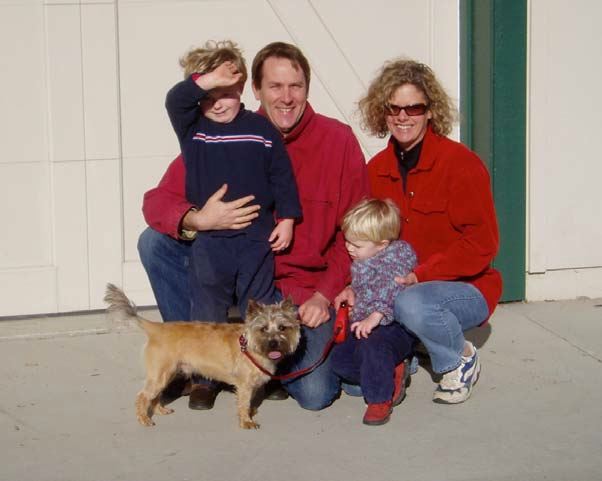
After graduating from Brown University, he was awarded a Samuel T. Arnold Fellowship and returned to France in the fall of 1980 to study viticulture and enology. He obtained his Enology degree from the Université de Dijon in 1981 and worked at many prestigious estates in Burgundy including Domaine Georges Roumier, Domaine Bruno Clair, Domaine De Villaine, and Domaine Dujac. Ted returned to the United States when his funds ran out and apprenticed with Josh Jensen at Calera Winery in Hollister, California. Surprisingly, late in 1982, while working at Calera, Ted was contacted by Jacques Seysses of Domaine Dujac, who asked him, “How would you like to make Meursault?” At Domaine Guy Roulot in Meursault, one of the owners of the oldest and most traditional wineries in Burgundy, Guy Roulot, had died and his family was searching for another winemaker. Guy’s son, Jean-Marc, was in love with the theater, not winemaking, and had not chosen to follow in his father’s footsteps. The Roulot family sought the advice of Jacques Seysses. “Of all the apprentices I’ve had, and I’ve had many, Jacques Seysses told Madame Roulot. “None has been as bright and capable as Ted Lemon. He has so many fine qualities, but there are two problems. He is twentyfive years old and he is American.” After consulting with Aubert de Villaine, Partrick Bize and others, Madame Roulot offered to make Ted the first, and still today, the only American winemaker and vineyard manager at a major domaine in Burgundy’s history. A young Ted Lemon is charmingly pictured below in Burgundy.

Upon returning to the United States, Ted was hired by a French family that had bought a vineyard on Howell Mountain above the Napa Valley. Ted became the founding vineyard manager, winemaker, and oversaw the building of a new winery. Chateau Woltner’s Chardonnays soon became a favorite among American wine connoisseurs. With his winemaking and winegrowing skills assured, Ted and his wife Heidi founded Littorai Wines in 1993. The name Littorai (lit’tor-i) is a pleural derivative of the Latin word littor, which means the “coasts.” Ted had spent a summer with his wife driving up and down the coasts of California and Oregon to taste local wines and learn the terroir and history of local vineyards. He believed the finest Pinot Noir and Chardonnay were grown along the true littoral (coastal) zone of the continent. He became convinced that the geology and mesoclimates of the extreme portion of the continent north of San Francisco were diverse enough to create a series of unique terroirs. Ted settled on sourcing his grapes from vineyards in western Sonoma County and western Mendocino counties. He set out to find the finest vineyards at the very boundary of where grapes could be successfully ripened. Ted’s winegrowing idiom is profoundly French and profoundly Burgundian since he learned from such eminent winemakers as Jacques Seysses, Aubert de Villaine, and Jean Marie Roumier. His years in France inspired him to base his winegrowing on terroir. Terroir-based winemaking postulates that wine of a single place produced by a single estate is the greatest expression of winemaking. Pinot Noir and Chardonnay wine grape varieties are uniquely suited to this philosophy. According to Ted, “I believe soil is of major importance in a wine’s character. It’s clear there are tremendous differences between wines made from vineyards right next to each other even if they are vinified and treated exactly the same way.” In speaking of the importance of soil and the future of West Coast Pinot Noir, Ted’s remarks to me from a few years ago still ring true today. “The future of West Coast Pinot Noir, and indeed all West Coast wines (I would include Oregon in warm vintages), lies in learning to work with our soils so that we can produce full, ripe and profound flavors at lower Brix levels, Brix levels which will naturally give us wonderful wines in the 12% to 14% alcohol range. Mother nature does this occasionally on her own. What I refer to as the “Ultrafornian” school of winemaking is not interested in balance in the classic, cuisine-driven sense. They are interested in flavor impact. They may speak of balance, but they are using the term in an entirely different way than we do at Littorai. Too often in California, winemakers pick fruit at absurdly high Brix levels, claiming that is the genius or forte of California terroir. Imagine the Northern European corollary: picking fruit very under-ripe because it emphasizes Northern European terroir (acidity and freshness). For all wine producing regions, there is a middle ground of striving to produce fully mature fruit which reflects the terroir in which it is grown. Fruit picked at perfect balance will always be the most crystalline reflection of the terroir in which it is born.” Ted was the first in California to create a “by-the-acre” contract for grapes in which he personally and closely supervised all aspects of vineyard management including pruning, fertilizing, irrigation and crop yields. In these contracts, growers are paid for the quality of what they grow, not the quantity. The first contract was written in 1993 for the One Acre Vineyard in the Anderson Valley that is part of Rich Savoy’s Deer Meadow Ranch. This type of contract is now the norm for premium Pinot Noir growers in California and Oregon. Ted was one of the first winegrowers who believed world class wine production could be achieved in California by low yields, proper clones, vertical trellising, leaf removal, and other now commonly used viticultural practices. Littorai has maintained a long term committed relationship with great vineyard sites such as Cerise, Charles Heintz, Hirsch, Mays Canyon, Savoy, Summa and Thieriot vineyards, and in the history of the winery, only one site has been discontinued. This is an exceptional record of terroir-based winemaking for California. Littorai was the first winery to vineyard designate Savoy Vineyard, Mays Canyon Vineyard, and Charles Heintz Vineyard. In recent years, Littorai has developed estate vineyards, now accounting for 39% of all production. Littorai has been farming organically since 2002 and now 90% of Littorai’s vineyard sources are farmed using only organically certified materials. 54% of vineyard sources are farmed biodynamically which Ted embraces wholeheartedly. Ted believes the clearest path to achieve wines of classic balance in California’s dry summers is biodynamics. He says, “We must improve the long term moisture retaining ability of our soils. Regardless of whether one practices biodynamic farming, the goal will be achieved primarily through increasing our soil humus content. Balancing organic matter levels, appropriate long term management of cover cropping, precise yield control, discriminate hedging and leafing, and judicious irrigation management will all play significant roles. What I describe is an arduous, lengthy undertaking. While any producer will be able to give lip service to such ideas, implementing them will be far more complex.” Ted’s experience has shown him that with rigorous winemaking, “Wine from a well-managed biodynamic vineyard expresses terroir like no other. Through biodynamic practices, many of the yearly, weather related difficulties experienced in the organic paradigm are overcome. In other words, we can produce vines which express the year and yet overcome its greatest challenges, all in a self sustained, self contained model.” Ted explains the philosophy of a biodynamic vineyard as generating as many of the farm’s needs as possible on site or close as possible. “The farm is a self contained organism which seeks to achieve a natural stasis with its environment. This balance will minimize (but not eliminate) pests and diseases. They will be reduced to a level which both plant and farmer can live with. The farmer works with celestial rhythms to further harmonize the farm with its environment. A good biodynamic farm is a bit like a monastery: a self contained, self supporting unit.” Ted’s winemaking approach emphasizes minimal intervention, long lees contact, and gentle handling of the fruit and wine. Pumps and filtration are avoided. All the Chardonnays are barrel fermented. The Pinot Noir wines are fermented in traditional open-top fermenters and at least some proportion of whole clusters are used. Punch downs are routine. All the wines undergo native yeast fermentation and complete malolactic fermentation, as long as nature does not dictate otherwise. The goal is to avoid high alcohol levels and overripe flavors, focusing on finesse, balance and length. Usually one-third to one-half new oak is used for aging the wines as an element of complexity, but never leading you to think of “oak” when tasting a Littorai wine. The objective is wines of balance and harmony that can improve and blossom with cellaring. As Ted remarks, “The key word here is patience: patient winemaking and patience from the consumer.” I would suggest that if you ever find older vintages of Littorai Pinot Noir and Chardonnay on the secondary market, buy them. I have acquired quite a few older vintages and enjoyed all of them immensely, especially the Pinot Noirs from One Acre in the Anderson Valley. Ted now has his own winery on his estate in Sebastopol, finished in time for the 2008 harvest (photo below is during construction). The winery is a straw bale building built on two levels on the side of a hill. The facility is designed for solar power (part of phase two construction) and to maximize energy efficiency. Winery water is reclaimed through an innovative constructed wetlands treatment system and will be reused for vineyard and farm irrigation. The best news is that Ted now receives visitors by appointment (707-823-9586) for tours and tasting at the new winery. As part of phase two construction, underground caves for barrel storage will be dug adjacent and connected to the winery. Littorai wines are sold exclusively to a mailing list at www.littorai.com. There is still a small amount of the 2006 vintage wines available and there is currently a secondary offering on the 2007 vintage. Contact Sheri Wood at 707-826-9586 or info@littorai.com.
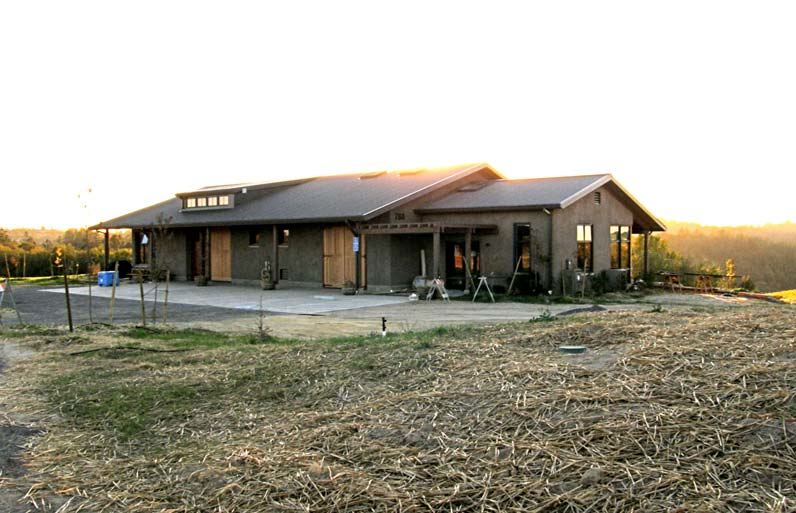 Ted is a life long winemaker passionately committed to his craft. He did not come into wine as a second career. His wines adhere to a personal esthetic sensibility. His impressive track record of consistent excellence with multiple vineyard sources and through fifteen vintages is impressive. If you splurge on one ultra-premium California Pinot Noir producer each year, Littorai should be a top consideration. Listen to my interview with Ted Lemon: http://www.graperadio.com/archives/2007/07/30/ted-lemon-and-thewines-of-littorai/
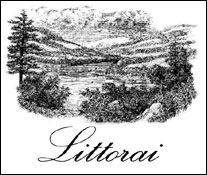
2005 - Serious, woodsy wines with notes of decaying earth. Lowest yields ever seen, averaging one-half ton per acre. 2004 - Highest acid Pinot vintage Littorai had made. Tannin levels are average. Sappy, nervy wines full of aromas of brier patch and dark recesses of forest. More palate weight and aromatic expression than 2003. 2003 - Wines have good color and concentration. Tend toward elegance and precision. Harvest coincided with a heat wave in Sonoma and Anderson Valley. Ted said in 2005 that the wines had no indications of the warm harvest conditions, but I do feel the wines now show cooked or roasted fruit notes (see my tasting notes). 2002 - Every lot from every vineyard had exceptional quality. The wines are uniformly dark and vibrant in color. The aroma range and purity are exceptional. Lower in alcohol than 2001. Plenty of tannin structure to give the wines long life, yet not a tannic vintage. 2001 - Normal yields. Ripe, classic fruit aromas, supple and seductive flavors. A forward vintage.
Tasting verticals is most instructive since it provides an understanding of vintage variation. Verticals offer the consumer a path to the realization that wines are not going to taste the same every year. Vintage differences are part of the charm of wine and should be celebrated. Tasting verticals also provides a better understanding of the process of winemaking and the challenges that winemakers confront year in and year out. I recommend that you seek out producers you admire, stay true to them year in and year out, and appreciate the vintages for the diversity they provide. Collect verticals, invite over some friends and pop the corks, and revel in the inevitable convivial conversation that will result.
In February, 1994, Ted Lemon, Burt Williams (Williams Selyem) and Steve Kistler (Kistler Vineyards) visited Hirsch Vineyard which is located in the outpost of Cazadero on the true Sonoma Coast. This was like the three Apostles traveling to the mountain to begin the transfiguration of Hirsch Vineyard. Each of the trio chose blocks from which to source fruit. Some of the blocks were shared between wineries and some were “monopole” blocks entirely designated to a single winery. David Hirsch, who began planting his vineyard in 1980, was a visionary but was not a trained viticulturist, and relied upon the trio, particularly Ted Lemon, to provide guidance for pruning, suckering, fertilizing, leaf removal, leaf thinning and pest control. All Littorai grape purchases were converted to a by-the-acre formula in 2001. Initially, Ted obtained grapes from a few different blocks. Each block was kept separate during production and then blended before bottling. Gradually, Ted refined his block selection and by 2001 he had some preferences. Beginning with the 2001 vintage, Littorai offered a Sonoma Coast bottling consisting primarily of declassified Hirsch blocks, so that only the very best of the Hirsch production was bottled as the vineyard designate. The declassifications have been as high as 50% of the total buys from the property. Starting in 2003, Ted restricted his purchases to Block 6, which has shown exceptional quality potential. The clones from this blocks are Swan, Pommard and Dijon 114. The soil is Hugo gravelly loam, usually found only on extremely steep and densely forested hillsides in Sonoma, and therefore rarely used for vineyards. The Littorai block has been committed to farming using only organically certified materials since 2008, the first on the property to be converted to organics. Littorai has always been the largest purchaser of Hirsch Vineyard fruit. The Hirsch Vineyard bottlings receive very little whole cluster fermentation, no press wine is added back, virtually all vintages are never racked between barrel down and the bottling tank, and the wines are unfiltered.
2003 Littorai Hirsch Vineyard Sonoma Coast Pinot Noir 14.1% alc., 660 cases, $50. · Very dark reddishpurple color. Ultra-ripe aromas of cooked cherries, raisins, black currents and a touch of porto. Rich and meaty on the palate, with a plethora of ripe, dark raisiny fruits with notes of earth and sassafras. Soft in the mouth with supple dry tannins. Too ripe and chunky for me. Decent.
 2004 Littorai Hirsch Vineyard Sonoma Coast Pinot Noir 14.3% alc., 300 cases, $55. · Heady aromas of black cherries, black currents, and spice. Delicious black cherries jump out on the palate with a hint of citric peel on the hi-pitched finish. This is a wine for those who say California Pinot Noir doesn’t have enough acidity. Very good.
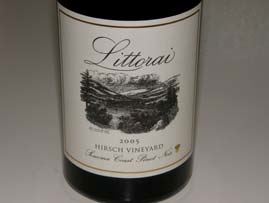 2005 Littorai Hirsch Vineyard Sonoma Coast Pinot Noir 13.5% alc., 84 cases, $63. · Really charming nose that is both floral and fruity with hints of leather and forest floor. Dark red and blue fruits are augmented by tastes of savory herbs and sweet oak. Notably structured with dry tannins perfectly balancing the lively acidity. Silky textured and quite harmonious. Very good.
2006 Littorai Hirsch Vineyard Sonoma Coast Pinot Noir 14.6% alc., 636 cases, $65. · Moderately deep garnet in color. Showy aromas of dark red stone fruits, slightly confected, with underlying baking spice and char. Medium-weighted and more elegant than the previous three vintages but with an admirable mid-palate attack of tasty dried cherries. Bright acidity, soft tannins and a slightly viscous texture come together in a very congenial package. Very appealing now but has the cajones and balance to age. Really sings with food (try it with a Pastrami sandwich, you will be surprised).
This 2-acre vineyard sits at 1,200 feet above the town of Bodega Bay, about five miles east of the Pacific Ocean. Cameron Thieriot planted his vineyard in 1994 with Pommard 4 and Dijon 114, 667 and 777 clones. The top soil is Goldridge sandy loam with underlying sandstone. Littorai has a 25-year lease on this vineyard and farms this vineyard organically for the owners.
1998 Littorai Thieriot Vineyard Sonoma Coast Pinot Noir 14.3% alc.. · Very potent and intense aromas of ripe black plums and black currents with hints of herbs, oak, cigar box and black olives. A big-boned, potent wine with a hint of roasted flavor to the dark, earthy fruits. Still sporting well-structured tannins. The least refined wine in this vertical tasting and the most out of character for a Littorai wine. Decent.
 2001 Littorai Thieriot Vineyard Sonoma Coast Pinot Noir 14.2% alc., 357 cases, $55. · Very fresh for an older wine with vibrant aromas cherries, berries, and sweet oak spice. Lip-smacking juicy cherry flavors dominate with a subtle hint of confection. Still young at heart with supple tannins, a silky mouth feel and a long and lush finish. Everything is in perfect harmony. Very good.
2002 Littorai Thieriot Vineyard Sonoma Coast Pinot Noir 14.25% alc., 205 cases, $55. · My favorite year for this vineyard. I have had this wine more times than I can count, and each time it was stunning. Unfortunately, this bottle did not quite match up to other lofty memories. Teasing, forward aromas of Bing cherries, wild strawberries and raspberries, and faint oak char. Tasty cherry and berry core with a hint of cola, tobacco, char and wood. Some lingering tannin and plentiful acidity for a refreshing finish. Very good.
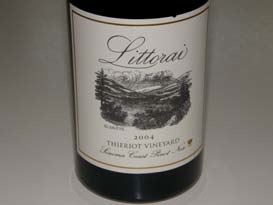 2003 Littorai Thieriot Vineyard Sonoma Coast Pinot Noir 14.6% alc., 100 cases, $60. · Strikingly pure with aromas of intense dark red cherries, strawberries, straw, grass, incense and mahogany. An appealing richness with a mid palate attack of delicious fruit that has a liquor-like lift to it. Despite its appealing hedonism, the wine has class and elegance displaying a very smooth texture and caressing tannins. You can’t say no to this one.
2004 Littorai Thieriot Vineyard Sonoma Coast Pinot Noir 14.4% alc., 200 cases, $65. · Lovely nose featuring fresh, sweet dark red cherries and berries and hints of straw and smoke. Discreetly concentrated black cherry and berry essence that is bright and clearly focused on the palate, ending with an aromatic and extended finish. Perfect in every way.
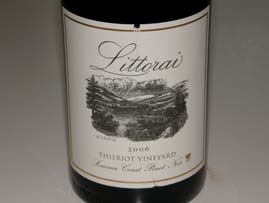 2005 Littorai Thieriot Vineyard Sonoma Coast Pinot Noir 13.8% alc., 48 cases, $70. · Predominant scents of straw and pine forest with berry fruit in the background. Earthy and herbal with a brooding red and blue fruit core, firm tannins and a silky mouth feel. Well-crafted, but doesn’t deliver enough Pinot love. Decent.
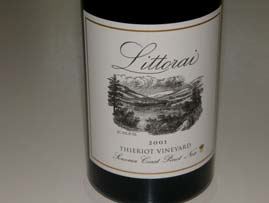 2006 Littorai Thieriot Vineyard Sonoma Coast Pinot Noir 13.9% alc., 305 cases, $70. · Clearly the most approachable and most seductive wine in the lineup. Ted says, “As gentle a wine as Littorai can make.” Heavily perfumed with Bing cherries, strawberries and Provencal herbs with a hint of incense. The redder fruits explode in the mouth, finding every crevice and lingering for some time. Lovely richness of flavor with gossamer tannins and bright acidity. Very harmonious with charm to thrill. As sexy as this Pinot is now, it has the balance to go the distance, so did feel rushed to pull the cork now.
Proprietors Scott and Joan Zeller planted their 4.25-acre vineyard on Taylor Lane east of Occidenta and just across the street from Thieriot Vineyard. Summa means “with the greatest honor.” Williams Selyem bottled a Summa Vineyard Pinot Noir as far back as 1988 that brought attention to the vineyard. The Summa Vineyard was always Burt Williams’ favorite while he was at Williams Selyem and his vineyard designate Pinot Noir from there was the first California Pinot Noir priced at three digits. Littorai and Rivers-Marie are currently the only wineries sourcing Pinot Noir from the Summa Vineyard. The vineyard is a mix of old vines (1.75 acres planted in 1977) and newer plantings (2.5 acres planted in 1998). The clone is a mystery to everyone but the owners. I have had wines from this vineyard over the years from Rivers-Marie, Brogan Cellars, Williams Selyem and Littorai that have been flat-out stunning. The Littorai Summa Vineyard Pinot Noirs sell out quickly every vintage.
2003 Littorai Summa Vineyard Sonoma Coast Pinot Noir 13.9% alc., 85 cases, $65. · Darkest in color of the four vintages in this flight. Aromas of black cherries, plums, black currents, Guiness and a hint of oak. Black fruited, intense and very ripe, almost syrupy with a slight raisiny flavor. So much fruit, it seems cloying. Very smooth and silky with a good acid underpinning. Decent
2004 Littorai Summa Vineyard Sonoma Coast Pinot Noir 13.7% alc., 36 cases, $70. · Heady aromas of fresh cherry tart and forest floor. Pure, fresh and vibrant. Ambrosial flavors of loamy dark cherries with a sidecar of savory herbs. Seamless, soft and sensual in the mouth with gentle tannins and a clean, fruity finish. Excellent.
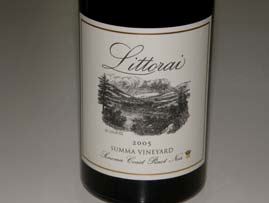 2005 Littorai Summa Vineyard Sonoma Coast Pinot Noir 14.2% alc., 24 cases, $80. · Similar to the 2004 vintage but a bit denser with more body. Alluring scents of black cherries, black raspberries, wood shed and mint. Luscious dark stone fruits with hints of herbs, earth and cola. Smooth, even creamy, with silky tannins. Perfectly balanced.
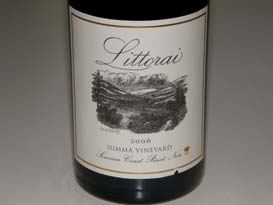 2006 Littorai Summa Vineyard Sonoma Coast Pinot Noir 13.7% alc., 121 cases, $80. · Lightest in color of the four vintages in this flight. Demure but enticing aromas of cherries and raspberries with a hint of Asian spices and oak. Veers a little more toward the redder fruit spectrum than the previous three vintages. Full-on generous flavors of creamy cherry and raspberry fruit. The flavors march in waves across the palate leading to a finish that won’t quit. Absolutely gorgeous and pure, and not propelled by high alcohol. A little lighter-weighted than the 2004 and 2005 vintages, yet equally, if not more satisfying with more finesse, yet possessing enough tannin to age. Close to a perfect California Pinot Noir and a sure fire First Team Pinot Noir All-American for 2009.
Calera Wine Co.: Burgundian Soul & SoilJosh Jensen goes by several adoring names conjured up by his employees and followers including “Generalissimo” and “Mr. Pinot.” Perhaps something with a French ring would be more appropriate such as “Monsieur Pinot,” since Jensen’s Calera Pinot Noirs are probably the closest to the Burgundian idiom of all Pinot Noirs in California. Calera Wine Company has just released its 31st vintage. In 1975, when Josh Jensen first planted his vines on a remote property in the Gavilan Mountains of California, he was among a few pioneers at the time who were attempting to grow Pinot Noir in California. It was the limestone that brought Jensen to this remote location. He was a student of and fervent lover of Burgundy and was convinced that it was the limestone in the soil of Burgundy that made the wines so special. Jensen has said, “Here in this country, the establishment doesn’t think limestone is important. I didn’t waste my time debating it. I just saw where the great Burgundies grow and decided to let my wines do the talking.” The name, Calera, is Spanish for lime kiln, referencing the old lime kiln left on the land when he acquired it. Jensen’s remarkable story was first told in detail in 1993 in the first edition of the book, The Heartbreak Grape, A Journey in Search of the Perfect Pinot Noir, by Marq de Villiers. A revised and updated version was published in 2006 (McArthur & Company, paperback, $10.99). Jensen’s saga is an inspiration for anyone hoping to follow a passion for Pinot Noir. Only recently, after thirty-four years, has Jensen’s heartbreaking efforts found vindication. Pinot Noirs from Calera can hold their own to the best from Burgundy. In 1975, Jensen cleared enough land in the hills of Hollister to plant three Pinot Noir vineyards, all located about a fifty minute drive from the winery. The vineyards were Jensen (named after his father, Stephen), Selleck (named after Dr. George Selleck, who first introduced him to wine), and Reed (named after his initial business partner). Mills (named after John Everett Mills who built the infrastructure on the property on Cienaga Road for a mining operation, the retaining walls eventually to become part of Calera’s gravity-flow winery), and Chardonnay and Viognier plantings followed in 1984. The Jensen Vineyard is nearly 14 acres, Reed is 4.4 acre, Selleck is 4.8 acres, and Mills is 14.4 acres. The most recent Pinot Noir planting is the Ryan Vineyard (named for Jim Ryan, the vineyard manager since Calera began) which is 13.1 acres and was planted in 1998 and 2001. There are also some unnamed plantings of Pinot Noir that have not yet produced commercially viable grapes. Jensen feels that there are locations on his property that may have even more potential for Pinot Noir than his original plantings.
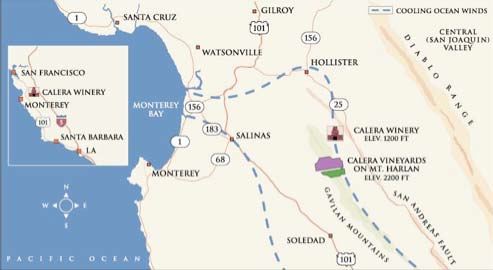
Jensen won’t say where the original clones of Pinot Noir that are planted at Calera came from. Selleck, Reed and two-thirds of Jensen are probably suitcase clones either originating directly from Domaine Romanee-Conti or indirectly from Chalone. The rest of the plantings are presumably nursery bench grafts sourced within California. All the Pinot Noir is planted onto nursery rootstock except Mills Vineyard which is own rooted. By 2006, Jensen had 83.6 acres planted on his 1088-acre property. The winery, the world’s first and only completely gravity-flow winery, was built on seven different levels into a hillside. Calera is the only winery in the Mt. Harlan AVA (he can also use the Central Coast AVA and San Benito AVA designations). Curiously though, the vineyards are in the Mt. Harlan AVA, but the winery technically is not, so he cannot use “estate bottled” on his labels. The first estate Pinot Noir was from the 1978 vintage consisting of 700 cases of half-bottles and was also the first Calera wine made at the winery. Calera Pinot Noirs are typically reticent and brooding upon release, with healthy tannic backbones, and with the balance to predict age ability. The best drinking window is often between five and twenty years after the vintage. The wines are not flashy, fruit-driven wines with upfront appeal like the so-called “Smasher-Blasters” that Jensen calls California’s fruit bombs. He says, “Smasher- Blasters are mostly one-dimensional, simple but potent beverages that will merely lose their fruit, their main if not their only appeal, with the passing years and just turn into....expensive mud.” His vision for the perfect California Pinot Noir is well reflected in the eloquent style of his wines, one “that is perfectly balanced on the cusp of richness and complexity, of fruitiness and subtlety, and neither one nor the other.” The Calera winemaking regimen is as follows. The grapes since 1984 have not been de-stemmed except for some purchased grapes and grapes from young vines. No cold soak is employed. Typically, tartaric acid is added, native yeasts drive fermentation, punch downs are by hand, and the wines undergo 100% malolactic fermentation in Francois Freres barrels, of which typically 30% are new. Racking is done twice into a fining tank (egg whites are used) and bottling tank. The single-vineyard Pinot Noirs are aged for 16 months before bottling. The Central Coast Pinot Noir is aged in 12-15% new barrels for 10-11 months. Calera wines are sold on the website at www.calerawine.com and through retail distribution. Current annual production is 30,000 cases. The portfolio includes seven different bottlings of Pinot Noir, Chardonnay, Aligoté, and Viognier. Interestingly, Jensen was the first to plant Viognier in California, petitioning the U.S.D.A. to import Viognier cuttings in 1973 when it did not exist in this country. The back labels are unrivaled for information.
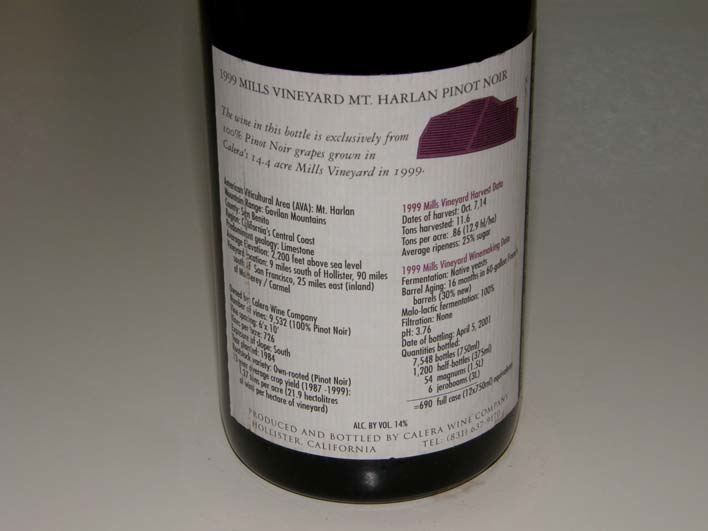
A bit of interesting trivia: What was the first full case of Pinot Noir that the Prince bought? Answer: 1985 Calera Jensen Mt. Harlan Pinot Noir.
2006 Calera Mills Vineyard Mt. Harlan Pinot Noir 13.5% alc., 1,795 cases, $38. Yields were 3.16 tons per acre. 44% of fruit was declassified. Aged 16 months in 30% new French oak. Unfiltered. · Alluring aromas of black cherries, earth, spice, smoke and subtle oak. A cherry bombast with teeth-coating tannins that are dry and astringent. Very smooth and silky in the mouth. Much better the next day from a previously opened and re-corked bottle. Patience will be rewarded. Very good.
2006 Calera Reed Vineyard Mt. Harlan Pinot Noir 14.4% alc., 929 cases, $42. Yields were 3.0 tons per acre. Aged 14 months in 30% new French oak. Unfiltered. · Lightest in color of the 2006 Pinot Noirs. Very charming perfume of redder fruits including strawberries and red currents with a hint of baking spice. Reddest fruit flavors of the 2006 Calera Pinot Noirs and the most elegant and approachable wine of the lineup. Very nuanced with notes of raspberries, pomegranate, forest floor, and minerals with a little steeliness to the finish. Plenty of upfront charm and still drinking beautifully the next day from an opened and re-corked bottle, indicating the potential for longevity.
2006 Calera Jensen Vineyard Mt. Harlan Pinot Noir 14.3% alc., 2,531 cases, $49. Yields were 3.06 tons per acre. Aged 16 months in 30% new French oak. Unfiltered. · Brooding stone fruits with a hint of oak char on the nose. More fruity and more appealing nose the next day from an opened and re-corked bottle. Velvety stone fruit core which is a touch earthy but primarily one-dimensional now. Still closed and unyielding, showing more leg, softness and character the next day from a previously opened re-corked bottle. A wine with plenty of charisma that will benefit from a few years in the cellar. Very good.
2006 Calera Selleck Vineyard Mt. Harlan Pinot Noir 14.2% alc., 793 cases, $63. Yields 2.43 tons per acre. Aged 16 months in 30% new French oak. Unfiltered. · On the nose there is intense loamy fruit accented by anise and grilled meat scents. Lovely depth and richness of lightly spiced cherry and raspberry fruit on the palate. Rich and full-bodied, yet very smooth with restrained tannins and a finish Hollywood would be proud of. Great scent, great purity and great persistence. Even better the next day from a previously opened and re-corked bottle. A great cellar candidate although it is hard to say no to now.
2005 Calera Mills Vineyard 30th Anniversary Vintage Mt. Harlan Pinot Noir 14.0% alc., 1,351 cases, $37. Yields 1.3 tons per acre. Aged 16 months in 18% new French oak. Unfiltered. · Needs air time or decanting to open up. Scents of dark berry jam, briar, oak and grilled meat. Robust jolt of earthy dark fruit attacks the palate, filling the mouth with flavor and finishing with a hint of grapefruit peel. Well-endowed with fine-grained tannins. Very good.
2005 Calera Ryan Vineyard 30th Anniversary Vintage Mt. Harlan Pinot Noir 14.0% alc., 1,410 cases, $40. Yields 1.61 tons per acre. Aged 16 months in 18% new French oak. Unfiltered. · Bold aromas of ripe black cherries and berries with a hint of sweet oak. The most Caliesque of the 2005 Pinot Noirs with flashy and luscious thick fruit tasting of black raspberries, plums, tar and earth. Full and rich on the palate with wellendowed tannins and a vein of fresh acidity. A hearty Pinot that needs hearty food. Still drinking fine the next day from a previously opened re-corked bottle. Very good.
2005 Calera Selleck Vineyard 30th Anniversary Vintage Mt. Harlan Pinot Noir 15.0% alc., 287 cases, $63. Yields 1.19 tons per acre. Aged 16 months in 18% new French oak. Unfiltered. · Brooding aromas of dark ripe fruits, raisin and seasoned oak. Ripe, but not overripe spiced cherry and berry core with an earthy bent. The alcohol is well-integrated, the acidity is bright and the mild dusty tannins make for easy drinking. Gets better and better in the glass over time. Very good.
2004 Calera Mills Vineyard Mt. Harlan Pinot Noir 15.0% alc., 1,209 cases, $40. Yields were 1.28 tons per acre. Aged 16 months in 15% new French oak. Unfiltered. · A wine that displays very overripe fruit aromas and flavors. On the nose, there are scents of cooked and spiced plums, prunes, raisins, porto, and old wood. The generous core of very ripe fruit is wrapped in flamboyant tannins. May soften more in time, but will always be a tannic wine. Decent
2002 Calera Jensen Vineyard Mt. Harlan Pinot Noir 14.5% alc., pH 3.67, 799 cases. Yields 0.97 tons per acre. Aged 18 months in 30% new French oak. Unfiltered. · Aromas and flavors of wild berry jam, smoke and oak. Very tasty berry fruit kissed by the earth with a tangy citrus lift on the finish. Still has plenty of dry tannins that should soften more in time. Very good.
2000 Calera Jensen Vineyard Mt. Harlan Pinot Noir 14.0% alc., pH 3.64, 919 cases, $40. Yields 1.06 tons per acre. Aged 16 months in 30% new French oak. · This wine was very slightly corked. It still retained some attractive aromas of dark stone fruits, wild flowers and spice. Very smooth in the mouth with muscular yet soft tannins. Flavors of anise and black tea augment the core of dark fruit which has moderately faded. I would like to taste a bottle that is not corked. Unsatisfactory (flawed).
1999 Calera Mills Vineyard Mt. Harlan Pinot Noir 14.0% alc., pH 3.76, 690 cases. Yields were .86 tons per acre. Aged for 16 months in 20% new French oak. Unfiltered. · Very nice aromatic profile of spiced plums, toast, incense, dark chocolate and old book. Tasty dried dark fruits with a hint of apricot. Grainy with plentiful tannins and a lengthy finish. This wine has held up remarkably well and is a real treat to drink. Very good.
1999 Calera Reed Vineyard Mt. Harlan Pinot Noir 14.5% alc., 240 cases. Yields were .91 tons per acre. Aged 16 months in 30% new French oak. Unfiltered. · Still great reddish-violet color. Aged bouquet of raisiny fruit, leather, cigar box and a hint of sherry. Delicate dark red fruit is overwhelmed by tannins. Soft in the mouth with hints of cinnamon, truffle and earth. Still has some charm and will appeal to fans of older Pinot Noir. Drink up, the tannins outweigh the fruit. Decent.
Some generalizations can be made about the different Calera Pinot Noir vineyards. Reed is always the most precocious and is less dense than the other wines. Selleck is Josh Jensen’s favorite almost every vintage and mine too for its intense aromatics and bright and spicy cherry and berry flavors. Mills has its fans but always seems a bit out of balance with the fruit dominated by tannins. Jensen is the most aristocratic with a degree of complexity and age ability that outshines the others. Ryan is the new kid on the block, fruity and fresh with a lively grip of acidity and minerality, and less likely age ability.
Scoring Wines Has Crew Up in ArmsIn the last issue of the PinotFile I used the popular 100-point scoring system to rate the wines reviewed in that issue. Since I have never been a proponent of scoring wines numerically, it was Intended to be an “October Fools” trick and possibly incite some controversial discussion. Surprisingly, it unleashed a large outpouring of opinion among the readership, a majority of whom were adamantly opposed to me adopting the 100-point scale as an integral part of my wine reviews. 65% of those responding prefer the reviews as they are currently presented without numerical scores. 25% wanted scores to accompany the written descriptions. 10% preferred some type of quantitative rating system other than numbers in addition to the descriptions that would create more of a basis for qualitative comparison. I have excerpted some of the more detailed comments below. Not surprisingly, most of those who preferred scores had responses that were very brief and to the point. NO! “Scoring reduces a complex, nuanced assessment to a single number.” “It is not possible to apply precise numbers to something so subjective.” “One of the reasons I subscribed to your newsletter is because I got more out of your descriptions of the wine without looking first at the score, which is what I tend to do with the 100-point system. I find that people make buying decisions more by score than by description of the wine when the 100-point system is in effect.” “I’ll admit that I fall into the scoring trap. I do buy wines based on their scores. However, I’ve often bought wines based on your recommendations as well. A critic can convey that a wine and/or a winery is outstanding in many ways, through words or numbers. Each approach has pros and cons. What I really want is the insight from someone who tastes hundreds of wines each year (something I can’t do). When I find that my tastes align with theirs, or when I unlock the key to understand which words (or numbers or icons) they use to bring attention to wines I’ll really like, I’m on the right track.” “You are a breath of fresh air and I like that. The Prince of Pinot tasting notes work for me because it is from your gut and heart. Putting scores on your notes would take the “extra” out of “extraordinary” for me. The Robert Parkers, Wine Spectators, etc., have their following, and you have yours, and it is growing!” “Leave things the way you do it now with no scores. Really, what is the difference between a 91 and 92?” “I’d stay away from scores. They are a slippery slope and they can definitely skew perceived quality in a relative sense especially viewed over time. I place way more emphasis on the write up.” “I’m certainly used to the scoring metrics of the big wine rags, but prefer your legacy approach of verbal descriptions and assessments.” “The feature of your newsletter that makes it unique and interesting is your word descriptions rather than a point award. On the other hand, it limits your appeal to the “quick fix” crowd. I prefer words. I like to read and understand, not glance, buy and brag.” “I’ve come to expect honest, if at times wonderfully elusive descriptions from you rather than a numerical score. I think the big name publications have warped our views. There seems to be a cut off line at around 87 that says anything less is relegated to the bottom shelf and not worth seeking out for the serious wine drinker. I’m convinced that a high or low score skews perception and defies reality whereas descriptions give us something to look for when we taste.” “I wouldn’t score. It has helped lead New World wines down a deceitful pathway to global mediocrity. The 100- point scale has nothing to do with the quality of wine. It’s obvious that those that score highest in Parker and the popular publications all share the same mundane pandering to high residual sugar and alcohol levels that push the envelope of reasonable taste to ridiculous extremes. I’d prefer you rate wine in relationship to its varietal fidelity, regional diversity and expression of the vineyard along with it’s unique geographical qualities.” “As long as you reserve scores over 95 for wines better suited to pouring over ice cream and waffles than to drinking, like the Advocate and the Speculator do, I’ve got no problem at all with 100-point scoring. For me personally, point scoring doesn’t add anything, but I don’t find it offensive either. I am reading the PinotFile more as a guide to producers worthy of attention than as a buying guide to specific bottles.” “I am not a big fan of 100-point scoring systems that depend on one person’s palate. If a wine must be scored, I believe that a blind tasting by a large and experienced panel is a fairer system.” “Terrible, terrible, terrible idea Prince! This is a sure fire way to make certain that PinotFilers cease reading your excellent reviews and look right to the score, which is what I admit to doing myself with “those other publications.” This is wine, it isn’t math class, and wine can’t be qualified with a sterile, academic classification system that only serves to encourage the “mine is bigger than yours” mentality. Scores will change the entire nature of your publication, robbing it of much that makes it so unique right now.” “Scoring of wines does not add helpful information. Your description of the wine, alcohol content, and special icon make me happy!” “You don’t need it (scores). It is your notes and content, coupled with the very fact that certain wines garner your attention more than others that is a recommendation in itself.” “Readers are much less likely to read your excellent descriptions of wines that get an 88 score, even though this wine might be suited to their taste. On a number of occasions my wife and I have enjoyed a wine at a restaurant and I have looked the score up after the meal. I have found some of these wines rated 88 or 89 by Parker (but higher by Wine Spectator). We still loved the wine and buying it was the right decision. I would recommend you not implement the numerical scoring system.” “One of the reasons I have enjoyed your newsletter and reviews for the past few years is the fact that you have brought a non-scoring approach to your reviews. I have seen your differentiating brand that includes part story teller. I have bought wines you written about simply because of the story and background you offer. Nobody is doing this. You bring insights to how something got into a bottle. You do a great job of describing how something tastes. Personally for me, scoring abstracts and obviates a broader dimension and personality of good wine. Frankly, it leaves me a bit cold. You tend to review upscale wine producers. You more than anyone know the work that goes into putting out a bottle. I think your earlier position of no scoring honors the efforts of those producing.” “It is very easy to cut to the chase when a score is given, but the words are what let people understand the flavors and sensations that provide a wine’s palate signature. Numbers can convey palate length in seconds, or color intensity or level of aromatics, but when broken up to that level still don’t really describe the palate like words. Words involve thought and real communication. The PinotFile forces the reader to understand the wine is not a passing snapshot.” “I must admit that I was a little disappointed to see the scores in the last issue. I have always enjoyed your writing with the outstanding descriptions of the wine. I also like the Pinot Geek. Reading about a wine ‘you could snuggle up to all night’ with the Pinot Geek icon seems more exciting than reading your great description and then a 92 or 93 rating. Somehow, even a rating in the 90s seems like a letdown after such good review writing descriptors that your do.” “I prefer not seeing the score. I feel so many good wines are never enjoyed because the score isn’t 92 or better. Tasting notes should always be the method of choice in determining a good wine to create a memory with!” “I like the reviews and information, without the scoring. Makes it seem more personal.” “Why should someone read your magazine rather than one of the 47 others that give scores?” “Frankly, I believe that if you attempt to numerically score for publication all the wines your taste, all the fun will be gone for you. “I don’t trust the scoring, too much bias in it. Everyone has a different palate and scores don’t tell you if you like a wine.” “One of the reasons I like your publication is because you don’t give scores. You are forced to read your descriptions, and count on what Rusty Gaffney says. I much prefer this to a point system. Besides the false objectivity of the point system, in a world where everyone is pressed for time, people start neglecting what is written, and just look for the number. To everyone’s detriment, I believe.” “I vote no regarding wine scoring for your newsletter. It’s overdone and over emphasized by the wine media. Better to have an experienced taster like yourself evaluate a wine for notable characteristics, obvious faults, etc. and share this information with your readers. The reader then benefits from the information without feeling compelled to like or dislike a wine because it scored 89 instead of 91.” “Keep the Kiss method. We love your traditional method of descriptions.” “Don’t score. It’s refreshing and differentiates you from the mainstream wine critic. Recommending the wine and describing it is plenty enough.”
YES! “I am a data nut so scoring gives more input and information. Once I get to know what YOUR 92 means, then the scoring is beneficial to me.” “More information is always better.” “I very much like your wine scores to be listed. It gives me a much better opinion of what you think of the wine.” “I think a quantitative, as well as qualitative, rating may be of assistance. I think Parker’s system has a false exactitude, and the difference between a 94 and a 95 is elusive to my palate. I think a five band rating separately for the quality and a five band rating based on cost per bottle would be of some utility. I would add a rating system to your descriptive narrative to yield a rough index of comparison.” “The easier the better. If I trust your commentary (I do), then why wouldn’t I trust your scoring. I like scoring.” “I have to admit, while I claim not to be a fan or proponent of number ratings for wine, I appreciate seeing and being guided by (to a limited extent) them. Given your history of clear and accurate narrative reviews, as well as some numeric ratings in the 80s in your first venture into numeric ratings, I trust that your numeric grading system will work.” “I don’t need it (scores) or really like it, BUT is probably does make commercial sense for you to introduce it. The reality is that the marketplace is sold on it.” “The combination of notes, your icons and the scores, in my mind is the best vetting system!” “I don’t have time to read every description. A point system is very important to me.” “Scores specifically identify your evaluation of each wine.” "I think it is very important that you do score the wines. The truth is there is way too much wine out there, and the only way to really get a sense of where a wine stands is to score it. Everyone who scores has a different palate and I think wine folks now understand that. Trying to ascertain what you really thought of a wine from your notes and relative to all the other wines that you taste throughout the year is just not possible. Scoring is the only way to have a true relative sense, based on your palate. You will be quoted much more if you do score. I have always thought the argument against scoring is a false one. Yes, wine is subjective, but with all things subjective, you the scorer do have a preference and that preference is best and easiest conveyed with a score. Maybe a score for a wine will change over time, so be it, it is the nature of wine.” “Scores are another way for me to learn your palate and judge what your comments mean compared to my palate.” “I know some folks find the scores ridiculous, but I for one enjoy them.” “I find the use of a numeric scoring system to be valuable. Once one becomes familiar with the reviewer’s tastes, preferences, etc., it is a very efficient way for a reader of reviews to segregate wines for purchase. I love your reviews, but it has taken me a long time and a lot of reading to get to know your “code.” You are never harsh in your criticism of wines in your reviews, so I have had to read many reviews and sample many wines to get to the point that I am confident when buying a wine that you have reviewed. My preference would be for you to be more straightforward in your reviews. If you don’t like the wine, just say so and don’t make us figure out the code. I think the numeric rating system would be a useful tool in that regard.”
COMPROMISE! “I would like to somehow see different levels of Pinot Geeks. One could be great, another stupendous, another other worldly, etc.” “If enough readers want scores, which I seriously doubt, offer a separate summary page listing the wines with a score.” “I am torn about what is preferable. I struggle in reading your reviews as to your preference for a wine that does not receive the Geek status. Many times I am unsure in your description whether the wine is simply good, better than average, etc. I think this is where a wine score or other icons would come in handy.” “I’ll continue to read your reviews whether you use a numerical scale or not as I have found some excellent Pinots from your recommendations and thoroughly enjoy reading about your excursions and reviews.” “I favor descriptions over numbers, but I am not opposed to a number system as long as it doesn’t detract from the current system.” “There are merits to both methods. A pure numerical score without tasting notes is worthless to me. Tasting notes without showing the taster’s bias are also worthless but probably less so. To me it is absolutely critical to know how the taster tastes for any system to be of value. You system was fine and I thought the numerical addition was a way to show your bias among wines you liked - cest la vie.”
In deference to those who requested a clearer breakdown and more straightforward delineation of the quality of wines reviewed, I will include the following in my reviews. The Pinot Geek Icon will continue to indicate a complete wine of exceptional quality. The Pinot Value Icon will remain the same, signifying a Pinot Noir that represents an exceptional price/quality ratio. Usually this is an inexpensive wine (often under $30) that offers the drinker varietal correctness as well as appealing aromatics, flavors and enough complexity to signify a bargain at the wine’s retail price. Very Good will indicate a distinctive and well-crafted wine. Decent will denote those wines that are undistinguished, but very drinkable. Unsatisfactory will signify a wine that is flawed or that I would not recommend. The words, Very Good, Decent and Unsatisfactory will appear at the end of the tasting description. On the Prince of Pinot website home page, you can click on Wine Reviews and then Notable Pinots page. The wines receiving the Pinot Greek Icon and/or the Pinot Value Icon are listed alphabetically by winery name and then chronologically by vintage and ascending price.
Pinot Briefs
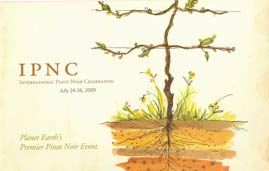 International Pinot Noir Celebration “The More the Merrier” promotion is available until December23, 2009. For the 2010 IPNC, groups of four guests receive $44 off each full weekend ticket and groups of ten guests are offered $97.50 per person savings. If you are a true Pinot Geek, you must attend IPNC sometime in your life. IPNC is the oldest, and still the best Pinot Noir festival in the world. Visit the website for tickets at www.ipnc.org. Ten Dollar Ruby Bronco Wine Company, the producers of Charles Shaw (“Two Buck Chuck”) wines marketed through Trader Joe’s markets, and the fourth largest wine producer in the world, has partnered with the Ruby Tuesday chain of over 800 restaurants to offer a Bronco Coastal Vines Chardonnay and Pinot Noir priced at $10 on the wine list. Bronco controls at least 35,000 acres of vineyards in the Central Valley (more than E&J Gallo) and is planting a new square mile of vineyards every year. The 89 Project This blog invites wine writers, reviewers, critics of any sort including bloggers to cross post anything they write about any wine getting an 89 rating. The idea is to give some well-deserved recognition to wines that do not crack the 90 barrier and as a result are often relegated to the graveyard of 89 point wines. Not for label kissers or score whores. Check it out at www.89project.blogspot.com.
 Buena Vista Carneros Tasting Room Now at Boudin at the Wharf Buena Vista, established in 1857 and California’s first premium winery, and Boudin Bakery, established in 1849 and San Francisco’s oldest continuously operating business, have partnered at Boudin at the Wharf in San Francisco. The Opening Celebration will be held on Thursday, October 22, 2009. Under the leadership of winemaker Jeff Stewart (right), the Pinot Noirs of Buena Vista Carneros now command utmost respect from Pinot aficionados. Brogan Cellars Library Offering Margi has opened her library and for a short time is offering older vintages of Brogan Cellars Lingenfelder Vineyard , Russian River Valley and Russian River Valley Reserve, My Father’s Vineyard (Burt Williams), Summa Vineyard, and Lone Redwood Ranch Vineyard Pinot Noirs in mixed cases. Magnums too! Inquire by calling 707-473-0211.
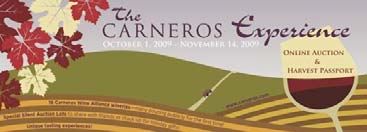 The Carneros Experience Online Auction & Passport From October 14 through November 14 the wineries of the Carneros Wine Alliance are hosting their first OnLine Auction offering unique Carneros wines and experiences. Examples of auction items: a bicycle excursion through the back roads of Carneros with 8 friends led by Clos Du Val winemaker John Clews followed by a sumptuous lunch and wines, a special BBQ, vineyard tour, and library wines from the cellar of Sangiacomo Family Vineyards with wine produced from Sangiacomo grapes and the opportunity to bottle your own wine under your own label with the Donum Estate winemaking team. Beneficiaries are the Carneros Land Stewardship Foundation and the Carneros Winegrowers Association’s Cru Carneros educational and training program for early stage wine and food professionals. The Carneros Harvest OnLine Auction runs concurrently with the Carneros Harvest Passport taking place on Saturday, October 17 at 18 wineries throughout the appellation. Tickets for the Passport event are available at www.carneros.com. View the OnLine Auction items at www.auction.carneros.com. Monterey Great Wine Escape Weekend Monterey Vintners & Growers Association (MCVGA) hosts the 13th Annual Great Wine Escape Weekend. The weekend of events includes notable winemaker dinners, tours of Monterey wine country (on luxury motor coaches or unescorted), educational tours at Chalone and Estancia, a wine-blending seminar at Paraiso Vineyards, and the Grand Finale where Monterey’s best wineries and restaurateurs will satiate attendees. Notable Pinot Noir producers participating include Carmel Road Winery, Hahn Estates, Morgan Winery, Paraiso Vineyards, Thomas Fogerty, and Ventana Vineyards. For more information and to buy tickets, visit the website at www.montereywines.org.
Joseph Swan Vineyards Cuvée de Trois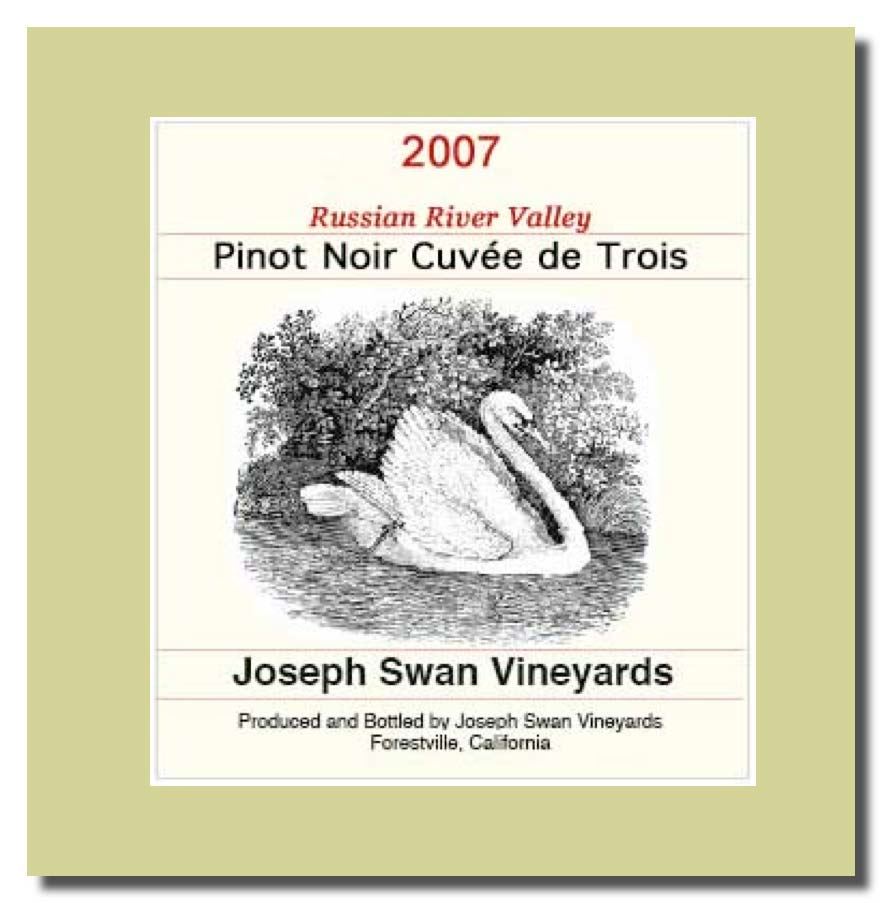 Joseph Swan Vineyards' long time owner and winemaker, Rod Berglund, has been bottling this wine since the 1999 vintage. Initially it was not expected to be but a tiny part of the winery’s total production, but by 2006, Cuvée de Trois had become 20% of production. The reasons were simple: it was a well-crafted, delicious wine with early approachability, and it was priced right. The wine is a blend, but Berglund notes, “We put every bit as much care and effort into making this wine as we do with our other Pinot Noirs. In fact, it includes all of our vineyard designated Pinot Noirs, including our Trenton Estate.” Each year in August Berglund tastes through all the Pinot Noir barrels on a five point scale and kicks out the lesser barrels. He then puts together trial blends of each of the vineyard lots. Once he has arrived at the proposed vineyard lot, he then makes a trial blend of what is left. Berglund says, “Usually I need to do some horse-trading with the potential vineyard-designate lots to make the Cuvée de Trois work. The goal is a wine that represents the terroir of the Russian River Valley as a whole. Year in and year out, I have found this to be a wine you can rely on to be fresh, vibrant, and harmonious, and one you can afford to drink on a regular basis. This is a dependable Russian River Valley offering that you can stock your cellar with as it will age for 5-7 years as well. The wine is available on the website at www.swanwinery.com and through limited retail distribution channels. Is there a better label in all of Pinot world?
2007 Joseph Swan Vineyards Cuvée de Trois Russian River Valley Pinot Noir 13.8% alc., 1,900 cases, $28. · Moderately deep reddish-purple robe. Great nose that draws you in featuring aromas of Bing cherries, red raspberries, slightest oak and violets, and a big dose of Asian Five Spice. Demure red berry and dried cherry core with an appealing touch of earth and oak. Silky smooth and elegant with the right mix of t n ‘a to bring the fruit into focus. Not a heavyweight, and even a little shallow in the mid-palate, but satisfying. The moderate alcohol adds to the appeal. Very good.
|